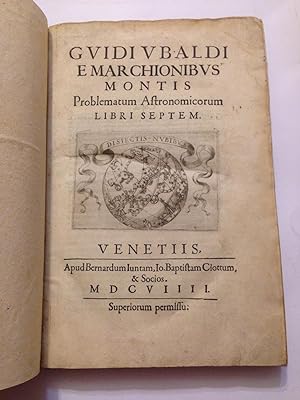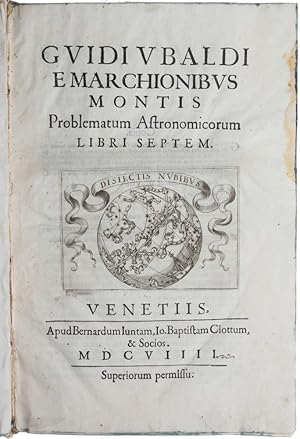MONTE, GUIDOBALDO DEL (21 resultados)
Tipo de artículo
- Todo tipo de artículos
- Libros (21)
- Revistas y publicaciones
- Cómics
- Partituras
- Arte, grabados y pósters
- Fotografías
- Mapas
-
Manuscritos y
coleccionismo de papel
Condición
Encuadernación
Más atributos
- Primera edición (7)
- Firmado
- Sobrecubierta
- Con imágenes del vendedor (9)
- Sin impresión bajo demanda (17)
Gastos de envío gratis
Ubicación del vendedor
Valoración de los vendedores
-
Le Mechaniche Dell'illustriss. Sig. Guido Ubaldo De' Marchesi del Monte
Publicado por Forgotten Books, 2018
ISBN 10: 0364205296ISBN 13: 9780364205297
Librería: PBShop.store US, Wood Dale, IL, Estados Unidos de America
Libro
PAP. Condición: New. New Book. Shipped from UK. Established seller since 2000.
Más opciones de compra de otros vendedores en IberLibro
Nuevo desde EUR 22,04
-
Guidobaldi à Marchionibus Montis Perspectivae Libri Sex (Classic Reprint)
Publicado por Forgotten Books, 2020
ISBN 10: 036585932XISBN 13: 9780365859321
Librería: Forgotten Books, London, Reino Unido
Libro Impresión bajo demanda
Paperback. Condición: New. Print on Demand. Excerpt from Guidobaldi à Marchionibus Montis Perspectivae Libri Sex. About the Publisher, Forgotten Books publishes hundreds of thousands of rare and classic books. This book is a reproduction of an important historical work. Forgotten Books uses state-of-the-art technology to digitally reconstruct the work, preserving the original format whilst repairing imperfections present in the aged copy. In rare cases, an imperfection in the original, such as a blemish or missing page, may be replicated in our edition. We do, however, repair the vast majority of imperfections successfully; any imperfections that remain are intentionally left to preserve the state of such historical works. This text has been digitally restored from a historical edition. Some errors may persist, however we consider it worth publishing due to the work's historical value. The digital edition of all books may be viewed on our website before purchase. print-on-demand item.
Más opciones de compra de otros vendedores en IberLibro
Nuevo desde EUR 17,93
-
Guidiubaldi e Marchionibus Montis Planisphaeriorum vniuersalium theorica (1579) [Leatherbound]
Año de publicación: 2022
Librería: S N Books World, Delhi, India
Libro Impresión bajo demanda
Leatherbound. Condición: NEW. Leatherbound edition. Condition: New. Leather Binding on Spine and Corners with Golden leaf printing on spine. Bound in genuine leather with Satin ribbon page markers and Spine with raised gilt bands. A perfect gift for your loved ones. Reprinted from 1579 edition. NO changes have been made to the original text. This is NOT a retyped or an ocr'd reprint. Illustrations, Index, if any, are included in black and white. Each page is checked manually before printing. As this print on demand book is reprinted from a very old book, there could be some missing or flawed pages, but we always try to make the book as complete as possible. Fold-outs, if any, are not part of the book. If the original book was published in multiple volumes then this reprint is of only one volume, not the whole set. IF YOU WISH TO ORDER PARTICULAR VOLUME OR ALL THE VOLUMES YOU CAN CONTACT US. Resized as per current standards. Sewing binding for longer life, where the book block is actually sewn (smythe sewn/section sewn) with thread before binding which results in a more durable type of binding. Pages: 148 Language: Latin Pages: 148.
-
Le mechaniche dell'illvstriss. sig. Guido Vbaldo de'marchesi del Monte. Tradotte in volgare dal sig. Filippo Pigafetta. Nellequali si contiene la vera dottrina di tutti gli istrumenti principali da mouer pesi grandissimi con picciola forza. . (1581) [Leatherbound]
Año de publicación: 2022
Librería: S N Books World, Delhi, India
Libro Impresión bajo demanda
LeatherBound. Condición: NEW. Leatherbound edition. Condition: New. Leather Binding on Spine and Corners with Golden leaf printing on spine. Bound in genuine leather with Satin ribbon page markers and Spine with raised gilt bands. A perfect gift for your loved ones. Reprinted from 1581 edition. NO changes have been made to the original text. This is NOT a retyped or an ocr'd reprint. Illustrations, Index, if any, are included in black and white. Each page is checked manually before printing. As this print on demand book is reprinted from a very old book, there could be some missing or flawed pages, but we always try to make the book as complete as possible. Fold-outs, if any, are not part of the book. If the original book was published in multiple volumes then this reprint is of only one volume, not the whole set. IF YOU WISH TO ORDER PARTICULAR VOLUME OR ALL THE VOLUMES YOU CAN CONTACT US. Resized as per current standards. Sewing binding for longer life, where the book block is actually sewn (smythe sewn/section sewn) with thread before binding which results in a more durable type of binding. Pages: 280 Language: Italian Pages: 280.
-
Le Mechaniche dell'Illustriss Sig Guido Ubaldo De' Marchesi del Monte Tradotto in Volgare Classic Reprint
Publicado por Forgotten Books, 2018
ISBN 10: 0364874201ISBN 13: 9780364874202
Librería: PBShop.store US, Wood Dale, IL, Estados Unidos de America
Libro
HRD. Condición: New. New Book. Shipped from UK. Established seller since 2000.
Más opciones de compra de otros vendedores en IberLibro
Nuevo desde EUR 37,20
-
Guidobaldi Marchionibus Montis Perspectivae Libri Sex Classic Reprint
Publicado por Forgotten Books, 2018
ISBN 10: 0366113216ISBN 13: 9780366113217
Librería: PBShop.store US, Wood Dale, IL, Estados Unidos de America
Libro
HRD. Condición: New. New Book. Shipped from UK. Established seller since 2000.
Más opciones de compra de otros vendedores en IberLibro
Nuevo desde EUR 38,36
-
Le mechaniche tradotte in volgare dal sig. Filippo Pigafetta nelle quali si contiene la vera dottrina di tutti gli istrumenti principali da mover pesi grandissimi con picciola forza. A beneficio [.] massimamente di capitani di guerra, ingegnieri, architetti [.].
Publicado por Venezia, appresso Francesco di Franceschi sanese,, 1581
Librería: Mayfair Rare Books & Manuscripts Ltd, London, Reino Unido
Libro Original o primera edición
Hardcover. Condición: Good. 4to (21cm), contemporary vellum with manuscript title on spine (upper board spotted and worn on lower edge); repairs to the lower margin of title-page, some dampstaining, but generally quite clean inside. Woodcut printer device on title, cursive type, text illustrated by several woodcut figures and diagrams. ff. 8, 127, 1 blank. First edition in Italian. Riccardi I/2p, col. 179: 'Questa e la prima opera nella quale siasi cominciato a dedurre rigorosamente dalla geometria i principi della statica e la determinazione dellÌeffetto delle macchine .'; G. Libri, cat. 1861, n. 2146: ÏLagrange says that the author has given the first application of the principle of vitesses virtuelles'; DSB IX, pp. 487/88: 'Guidobaldo's first books, this work was regarded by contemporaries as the greatest work on statics since the Greeks. It was intended as a return to classical Archimedean models of rigorous mathematical proof .'; Libri, Hist. Math. IV, p.79-81; Duhem, Orig. de la statique I, pp. 213-26; Drake-Drabkin, Mechanics in the XVIth cent. in Italy, pp. 48-52; Roberts-Trent, Bibliot. Mechanica, pp. 228/9.
-
Guidubaldi e Marchionibus Montis Perspectivae Libri sex
Publicado por apud Hieronymum Concordiam, Pisauri, 1600
Librería: Libreria Ex Libris ALAI-ILAB/LILA member, Roma, Italia
Carta d attesa antica. Nervi e titolo manoscritto su etichetta cartacea al ds. Entro custodia telata moderna. Alcuni forellini ed una mancanza al margine inferiore interno bianco del frontespizio. Taglietti, senza alcuna perdita, alle pp. 227 e 306. Lievi fioriture, peraltro del tutto assenti sulla maggior parte delle carte. Esemplare genuino e a pieni margini. Provenienza: collezione Moretti, Roma. Prima rarissima edizione di questo libro fondamentale per la storia della prospettiva. Dal Monte fu amico di lunga data e sostenitore di Galileo e su di lui ebbe una forte influenza, soprattutto nelle teorie di meccanica. L opera è considerata il culminating book in the phase of mathematical perspective. His Perspectivae libri sex provided a definitive and often original analysis of the mathematics of perspectival projection, in a far more extended way than either Commandino or Benedetti had aimed for. His most significant contribution comes in the first of his six books. His two opening demonstrations plunge the reader immediately into the heart of the matter, providing complex but lucid demonstrations of a flat figure and a three-dimensional object in perspectival projections (Kemp M., The Science of Art: Optical Themes in Western Art from Brunelleschi to Seurat , pp. 89 e ss.). Cfr. Riccardi I, 179; Br. Libr., 446. 4to (cm. 31,4), 2 cc.nn., 310 pp., 1 c.nn. Frontespizio con grande vignetta raffigurante un poliedro e oltre 300 diagrammi xilografici n.t.
-
Planisphaeriorum universalium theorica.
Publicado por Pesaro: Hieronymus (Girolamo) Concordia, 1579
Librería: Mayfair Rare Books & Manuscripts Ltd, London, Reino Unido
Libro Original o primera edición
Hardcover. Condición: Good. 4to (the leaf 252 x 175 mm), contemporary blind-tooled pigskin, red edges, a clean and well-preserved copy (some marginal worming to last leaves, not affecting text, small blank marginal portion of title-page cut away and carefully repaired, the line border finely supplied by hand). Title within line border and geometrical large woodcut vignette, woodcut capital letters, all the text within typographical border, pp. (8), 128, (4, last 3 blanks), illustrated with 73 woodcut diagrams in the text (11 of which full-page). With final blank R2. First Edition of the first book on astronomy by Galileo's patron. Riccardi describes the work as 'Raro e pregiato', adding that it is noteworthy in its application of optics and the use of projections in demonstrating the relative properties of figures. Houzeau-Lancaster identify an octavo edition published in 1560, but this is erroneous (Guidobaldo would have been only 11 years old). It was probably mistaken with the second octavo edition of 1581. Guidobaldo was Galileo's patron and friend for twenty years and possibly the greatest single influence on the Mechanics of Galileo. In addition to giving Galileo advice on statics, Guidobaldo discussed projectile motion with him, and both scientists reportedly conducted experiments together on the trajectories of cannonballs' (P.L. Rose in DSB IX, p. 487). This is of one of the non-mechanical works of Guidobaldo with important applications to map making, involving the author in polemical debate with Gemma Frisius and de Rojas. Adams U-9; BL/STC Italian Books p. 446; Houzeau and Lancaster I, 3285 (mistakenly citing a 1560 first edition); Riccardi I/2 p., col. 179.2.
-
In duos Archimedis Aequeponderantium Libros Paraphrasis Scholiis illustrata
Publicado por Hieronymus Concordia, Pesaro, 1588
Librería: Martayan Lan, New York, NY, Estados Unidos de America
Hardcover. Condición: Very Good. 4to.,[29.7 x 19.7 cm], (2) ff., 202 pp., (1) f. Bound in 18th C mottled calf, some rubbing, with title gilt on spine. Ex libris of Alexander Henry Davis on front pastedown. Title soiled, cancel on p. 9, corner of 1 leaf torn, trace of former library stamp on f.R2, pp.155-58 misbound. Light toning on scattered leaves, but overall a bright copy, very good. First edition of an Archimedean work by Galileo¿s friend and early patron Guidobaldo del Monte. Guidobaldo¿s Liber mechanicorum (1577), regarded as the greatest work on statics since the Greeks, employed the mathematically rigorous proofs of Archimedean models in investigating static and mechanical questions; the present work develops many of those ideas in a paraphrase of Archimedes¿ ¿On the Equilibrium of Planes,¿ which applied geometry to hydrostatics and proved the law of the lever using pure geometry. These works had a profound and lasting impact on the methodology adopted by 16th C Italian scientists, most notably Galileo: ¿Guidobaldo was Galileo¿s patron and friend and was possibly the greatest single influence on the mechanics of Galileo¿ (DSB). In addition to his patronage, Guidobaldo also supported Galileo¿s bid for Chair of Mathematics at the University of Padua in 1592. Galileo himself, who was sent a copy of the present work, adopted Guidobaldo¿s analysis of the lever. Guidobaldo del Monte (1545-1607, born to a wealthy family from Urbino, was a soldier, military engineer, astronomer and mathematician. In addition to writing works of applied geometry and physics, he also wrote on perspective, and he developed mathematical instruments including the proportional and elliptical compass. * Riccardi II.179; DSB IX.487-489; Bibliotheca Chemico-Mathematica, 12033.
-
In duos Archimedis Aequeponderantium libros paraphrasis scholijs illustrata. Pesaro: apud Hieronymum Concordiam, 1588 [colophon, 1587]. [Bound with:] SCALETTI, Carlo Cesare. Scuola mecanico-speculativo-pratica in cui si esamina la proporzione, che hà la potenza alla resistenza del corpo grave, e la causa per la quale la suddetta potenza si estenda a maggior'attività mediante la machina; opera utile all'uso civile, e militare necessaria ad ogni matematico, ingegniero, architetto, machinista, e bombardiere. Bologna: Costantino Pisarri, 1711
Publicado por apud Hieronymum Concordiam; Costantino Pisarri, Pesaro; Bologna, 1711
Librería: SOPHIA RARE BOOKS, Koebenhavn V, Dinamarca
Miembro de asociación: ILAB
Original o primera edición
Hardcover. First edition. THE GREATEST OPUS OF 16TH CENTURY MECHANICS. First edition, the beautiful Macclesfield copy, of Guidobaldo's Paraphrasis, the important companion to his Mechanicorum liber (1577), regarded as the greatest work on statics since the Greeks, which employed the mathematically rigorous proofs of Archimedes to the investigation of problems in mechanics. "This work complements the Mechanicorum liber, and together they represent the greatest opus of 16th century mechanics" (Roberts & Trent, p. 13). They had a profound and lasting impact on the methodology adopted by contemporary century Italian scientists, most notably Galileo: "Guidobaldo was Galileo's patron and friend and was possibly the greatest single influence on the mechanics of Galileo" (DSB). The Mechanicorum liber had reduced the study of simple machines to the law of the lever, according to which bodies balance on the ends of a lever when their distances from the fulcrum are inversely proportional to their weights. Guidobaldo's 1588 work is a paraphrase of Archimedes' 'On the equilibrium of plane figures,' which included a geometrical proof of the law of the lever. This is Archimedes' most important surviving work in mechanics, but much of it "is undoubtedly not authentic, consisting as it does of inept later additions or reworkings" (DSB). Guidobaldo's purpose in the Paraphrasis is to explicate and correct the Archimedean text, thereby providing a secure geometrical foundation for the law of the lever, and hence for the whole of the science of statics. "The Law of the Lever was among the first laws of nature to be formulated in quantitative terms. It dates back at least to Archimedes' On the Equilibrium of Planes and possibly even to Aristotle's Mechanics. Shortly after its first formulation, scholars like Archimedes and Euclid were already seeking to prove it by means of deduction from general axioms and postulates. The Law of the Lever thus comprises the very core of rational mechanics" (Schlaudt, p. 93). Like Archimedes, Guidobaldo also considers the application of the law of the lever to the determination of centres of gravity: of plane figures bounded by straight lines in the first book, and in the second book segments of conic sections (treated by approximating these curved figures by inscribed polygons). Monte's work is here bound with the rare first edition of Scaletti's treatise on civil engineering, with chapters on statics, mechanics, on the practical construction of fountains, buildings, bridges, etc. (BL only on COPAC; only three other copies located in auction records). "Guido Ubaldo, Marquis del Monte, was born at Pesaro on 11 January 1545. He entered the University of Padua in 1564, where one of his companions in study was the poet Torquato Tasso. On his return from the university, he continued his studies in mathematics under Federico Commandino at Urbino" (Drake, p. 44). "Writing to a friend in Paris in 1633, Galileo declared that 'at the age of twenty-one, after studying geometry for two years he worked out a number of propositions about the center of gravity of solids.' Galileo had become acquainted with Commandino's Liber de centro gravitatis solidorum that had been published in 1565 and had opened, or rather reopened, a new field of research but suffered from what Galileo called 'some imperfections.' These he sought to set right by following the example of 'that very great mathematician,' Guidobaldo del Monte, to whom he sent his demonstrations" (Shea, pp. 97-98). "In 1588 [Guido Ubaldo] received from Galileo some theorems on centers of gravity with a request for his opinion. In this way a correspondence was opened which continued until his death in 1607. Guido Ubaldo was favourably impressed with Galileo's talents, and sent to him a copy of his second important contribution to mechanics, a paraphrase of and commentary on the work of Archimedes on plane equilibrium [the offered work] . In appraising probable influences on Galileo, one should remember that, before Galileo wrote anything on motion, he had received this book from his most valued patron, [and] that it was a book on Archimedes (whom Galileo admired above all other writers)" (Drake, pp. 45-46). "Guido Ubaldo's two chief works on theoretical mechanics make clear his devotion to the idea of mathematical rigor of treatment and his repugnance for medieval writings on the science of weights and for Tartaglia's adherence to that tradition. The Mechanics contains numerous criticisms of these writers, and in the Paraphrasis of 1588 Guido Ubaldo wrote: 'And however much Jordanus Nemorarius (whose followers include Niccolo Tartaglia and others) struggled in his book De ponderibus to prove this same proportion of the general lever by many means, yet not any of the proofs were worthy to be called demonstrations, and were scarcely to be credited. For he put things together which in no way command conviction and perhaps do not even persuade anyone by probability, when in mathematical demonstrations the most precise reasons are required. And on that account it never seemed to me that this Jordanus should even be reckoned among writers on mechanics'" (ibid.). "With the Paraphrasis, Guidobaldo attended to restore the integrity of the Equilibrium of Planes, Archimedes's principal work of mechanics. The corrupted text presented Guidobaldo with problems of essentially three kinds: minor technical problems, like missing argumentative steps in the demonstrations; completely inconclusive demonstrations that requested a massive intervention in the text with lemmata or auxiliary propositions; and, most seriously, obscurities regarding the key notions of Archimedean mechanics. Approaching this challenge, Guidobaldo adopted a quite 'philological' modus operandi: firstly, to establish a correct text, he had recourse to the Greek version of the editio princeps (1544), which appeared to him less corrupt than the existing Latin translations. In the course of the Paraphrasis, he in.
-
De Cochlea Libri Quatuor
Publicado por Evangelisto Deuchino, Venice, 1615
Librería: SOPHIA RARE BOOKS, Koebenhavn V, Dinamarca
Miembro de asociación: ILAB
Original o primera edición
First edition. THE THEORY OF THE ARCHIMEDEAN SCREW - THE MACCLESFIELD COPY. First edition, the Macclesfield copy, of this very rare and important work of Renaissance engineering and mathematics, Guidobaldo's analysis of the theory and operation of Archimedes' most famous mechanical invention, the 'cochlea' or 'Archimedean screw'. This is a device used for raising water consisting of a helical tube wound around the outside of a cylinder; when the cylinder is inclined at an angle to the horizontal and the lower end of the tube is placed in water, rotating the cylinder causes water to be raised through the tube and ejected from the top. The Archimedean screw, and other variants of it, is still in use today; it is also used in reverse to generate hydraulic power (when water is poured into the tube at the top it causes the screw to rotate). The first to correctly explain the functioning of the Archimedean screw was Galileo: in Le meccaniche (written around 1600 but not published until 1634), he wrote that "the screw-pump 'is not only marvellous, but it is miraculous' ('non solo è meravigliosa, ma è miracolosa'), because in the screw-pump the water ascends by continually descending" (Koetsier & Blauwendraat, p. 188). But De Cochlea is the first printed account of how the screw-pump actually works. "The four books on the cochlea by Guido Ubaldo del Monte (1545-1607) are almost unknown to scholars who studied Archimedes' machine (perhaps due to the fact that the author used the Latin language in the few copies that were printed and to the different ways in which the author's name has been spelled over time) . Galileo himself requested a copy of it from Guido Ubaldo" (Magnini & Molari). Guidobaldo's analysis of the Archimedean screw was not improved upon until the 18th century, when calculus methods (invented by Newton half a century after the publication of De cochlea) were applied to the problem by Daniel Bernoulli in Hydrodynamica (1738) and by Leonhard Euler in his paper 'De cochlea Archimedis' (Novi Commentarii academiae scientiarum Petropolitanae 5 (1760), pp. 259-298). "Guidobaldo was Galileo's patron and friend for twenty years and was possibly the greatest single influence on the mechanics of Galileo" (DSB). Guidobaldo was also influential in securing appointments for Galileo, first at Pisa and then Padua. Together they conducted a series of experiments on the trajectories of cannonballs, asserting that projectiles follow parabolic paths. "After [Federico] Commandino's death in 1575, the commitment to the restoration of Greek mathematics was carried on by his disciples Guidobaldo dal Monte and Bernardino Baldi, to whom he had taught mathematics from about 1568" (Frank). According to Stillman Drake (p. 35), Guidobaldo was writing De Cochlea in the early 1590s: "In September 1593 Guidobaldo wrote an invitation to Galileo to visit him at Monte Baroccio . His patron wanted to show him a book on perspective he had written but not yet published . Guidobaldo was also writing a book on the Archimedean screw; this was probably related to a patent Galileo obtained in September 1594 on a device for raising water by horse power." However, Guidobaldo's book on the screw-pump was not published until after his death more than a decade later, by his son Orazio. ABPC/RBH list no other copy in a contemporary binding since the Honeyman sale in 1978. Provenance: The Earls of Macclesfield (South Library bookplate on front pastedown, small embossed stamp to first three leaves); sold Sotheby's, April 14, 2005, lot 1439, £2,880 ($5,461). The Archimedean screw is one of the oldest machines still in use. "The earliest representation of a water-screw is on a fresco from the Casa di P. Cornelius Teges in Pompeii, obviously dating from before 79 AD. On the fresco an individual is moving a cylinder with his feet in a landscape that is allegedly Egyptian. Because water comes out of the cylinder it is generally assumed it must be a water-screw. From the imperial period we have two other Egyptian representations (in the British Museum and the Archaeological Museum Cairo, respectively) and an Egyptian model of a water-screw (in the Hilton-Price collection). Moreover, remains of water-screws dating from the imperial period have been found in mines in Spain. None of these representations or remains of water-screws dates from before the time of Archimedes" (Koetsier & Blauwendraat, p. 182). "Its invention has traditionally been credited to Archimedes (ca. 287-212 BCE). For example, Diodorus Siculus (Greek historian, circa first century BCE) writes: 'men easily irrigate the whole of it [an island in the delta of the Nile] by means of a certain instrument conceived by Archimedes of Syracuse, and which gets its name [cochlias] because it has the form of a spiral or screw.' And from Athenaeus of Naucratis (Greek historian, circa 200 AD): 'The bilge-water [of the ship Syracusia], even when it became very deep, could easily be pumped out by one man, with the aid of the screw, an invention of Archimedes'" (Rorres, p. 72). "Drachmann has argued (p. 153) that Archimedes invented the screw-pump after having seen in Egypt the operation of a water-drum or tympanum (a water-lifting wheel with a body consisting of eight compartments). While the tympanum rotates, water enters a compartment through a hole close to the periphery of the drum, and after half a turn the water leaves the compartment again through a hole close to the axis. Oleson, who sympathises with Drachmann's reconstruction, described the moment of Archimedes' breakthrough as follows (p. 298): 'if the tympanum were to be drawn slowly along the axis of its rotation as it turned, its compartment walls would describe the spirals of just such a screw'" (Koetsier & Blauwendraat, p. 183). Koetsier & Blauwendraat argue that Archimedes may have been led to the discovery by his interest in the problem of the quadrature of the circle, equivalent to the problem of constructing by ruler and compass a.
-
Perspectivae libri sex."
Publicado por "Pesaro, Girolamo Concordia", 1600
Librería: Mayfair Rare Books & Manuscripts Ltd, London, Reino Unido
Libro Original o primera edición
Hardcover. Condición: Good. "Folio (305 x 205 mm.), 18th s cent style binding in half vellum with marbled paper on covers, title in gold on label at spine, a clean copy in excellent condition, with some contemporary scattered manuscript marginalia, see i.e. the long manuscript note at p. 101 (a few light marginal foxing). Woodcut diagram on title, woodcut initials, pp. [4], 310, [2], illustrated throughout with numerous diagrams in text (leaf *2 misbound between ff. A4 and B1). - The best renaissance study of perspective - First Edition of this important landmark in the history of perspective science, which provided a definitive analysis of the mathematics of perspectival projection, and established the s.c. vanishing point , discussed at length by Vagnetti, who gives a resume of the text, and Martin Kemp in The science of art (1990), p. 89 ff. "The best renaissance study of perspective" (DSB IX, 488). Berlin Katalog 4703; Cicognara 837; Adams U-8; Riccardi I/2, col.179; Vagnetti EIIb41; Poudra, Histoire de la perspective, Paris, 1864, p. 185, not in Fowler.".
-
Problematum Astronomicorum Libri Septem
Publicado por Apud Bernardum Juntam, Io Baptistam Ciottum & socios, 1609
Librería: Rossignol, Paris, Francia
Libro Original o primera edición
Couverture rigide. Condición: Bon État. 1ere Édition. Venetiis, Apud Bernardum Iuntam, Io. Baptistam Ciottum, & Socios. MDCVIIII. Superiorum permissu. Reliure plein velin, dos à nerfs avec titres manuscrits. Dimensions: 22,5 x 33,8 cm. 1(f), titre avec vignette gravée, 1 feuille d'introduction, 4 feuilles d'index, 128 feuilles, 1(f). Erreur de numérotation de la feuille 17 à la feuille 40. Exemplaire complet de cette première édition, illustrée de très nombreuses gravures in texte. Habile restauration dans la marge du feuillet 22. Ouvrage prépondérant du maitre et ami de Galilée, Guidobaldo del Monte, ou Guidobaldi, ou encore Guido d'Ubalde1 (né le 11 janvier 1545 à Pesaro dans la province des Marches - mort le 6 janvier 1607 dans son château de Montebaroccio), Marquis del Monte, était un mathématicien, philosophe et astronome italien du XVIe siècle. Ses travaux de statique annoncèrent la notion de travail mécanique. Il développa de nouvelles méthodes de calcul du centre de gravité pour des surfaces et des volumes variés. Il était sûrement, d'après Galilée lui-même, un des plus grands spécialistes de mécanique et mathématiques du 16ème siècle. Size: In Folio.
-
Problematum Astronomicorum Libri Septem
Publicado por Bernardo Giunta & G.B. Ciotti, Venice, 1609
Librería: SOPHIA RARE BOOKS, Koebenhavn V, Dinamarca
Miembro de asociación: ILAB
Original o primera edición
Hardcover. First edition. RENAISSANCE ASTRONOMICAL INSTRUMENTS. First edition, very rare, of the principal astronomical work of one of the greatest Renaissance mathematicians. "Guidobaldo was Galileo's patron and friend for twenty years and was possibly the greatest single influence on the mechanics of Galileo" (DSB). Guidobaldo was also influential in securing appointments for Galileo, first at Pisa and then Padua. Together they conducted a series of experiments on the trajectories of cannonballs, asserting that projectiles follow parabolic paths. The present work, originally composed in the 1580s but published posthumously by Guidobaldo's son Orazio, is devoted to mathematical astronomy, but is particularly notable for its descriptions of several newly invented instruments, both for making astronomical observations and for carrying out the calculations involved in solving problems in astronomy. These include an 'astronomical theodolite' for measuring the altitude and azimuth of celestial bodies, and a geared instrument which can divide circular arcs into degrees, minutes, seconds, thirds, and so on. "Guidobaldo helped to develop a number of mathematical instruments, including the proportional compass, the elliptical compass, and a device for dividing the circle into degrees, minutes, and seconds" (DSB). "In general Guidobaldo's attitude to mathematical instruments paralleled his attitude towards machines. Through these material devices, he felt, abstract mathematical truth could be made completely visible" (Rose, p. 224). A letter written by Orazio on 26 August 1609 documents that he "had contacted Galileo in order to ask advice about the publication [of the Problematum Astronomicorum]: Galileo seems to have answered to the former to have 'learned many new things' from the Problematum Astronomicorum Libri septem and to 'appreciate it very much'" (Frank, p. 547). The first book of the Problematum Astronomicorum contains Guidobaldo's descriptions of his instruments; the next four books deal with typical problems of mathematical positional astronomy; the sixth book is devoted to the estimation of the depression of the Sun towards the horizon at the beginning of the morning twilight and at the end of the evening twilight; and the seventh (and last) book is on comets. ABPC/RBH records no sales of this book at auction since the Macclesfield copy in 2005 (part of a sammelband), and only one before that (Christie's New York, November 13, 1996, lot 408, $5,175). Guidobaldo del Monte (1545-1607) was one of the most prominent Italian mathematicians from the second half of the sixteenth century. He was a nobleman from the Duchy of Urbino and occupied a central position at the courts of the Dukes Guidobaldo II and Francesco II della Rovere for large part of his life, until he fell out of favour in the 1590s. He studied mathematics at Padua, and later at Urbino he became the friend and pupil of Federico Commandino, whose translation of Pappus he edited and published. He combined practical work as an architect, designer of instruments, and surveyor of fortifications, with theoretical works on astronomy, perspective and mechanics. In cosmology he appears to have been an orthodox Aristotelian, as judged by his reaction to the supernova of 1604. Notwithstanding this latter position, he was also one of the most important patrons of the young Galileo. Together with his brother, Cardinal Francesco Maria del Monte (well known for having been a patron of Caravaggio), he helped Galileo secure his first teaching positions at the University of Pisa (in 1589) and Padua (in 1592). His "first book, the 'Liber mechanicorum' (1577), was regarded by contemporaries as the greatest work on statics since the Greeks [and his 'Perspectivae libri sex' (1600)] the best Renaissance study of perspective . Guidobaldo was Galileo's patron and friend for twenty years and was possibly the greatest single influence on the mechanics of Galileo. In addition to giving Galileo advice on statics, Guidobaldo discussed projectile motion with him, and both scientists reportedly conducted experiments together on the trajectories of cannonballs. In Guidobaldo's notebook (Paris MS 10246), written before 1607, it is asserted that projectiles follow parabolic paths; that this path is similar to the inverted parabola (actually a catenary) which is formed by the slack of a rope held horizontally; and that an inked ball that is rolled sideways over a near perpendicular plane will mark out such a parabola. Remarkably the same two examples are cited by Galileo at the end of the Two New Sciences, although only as postscripts to his main proof-which is based on the law of free fall-of the parabolic trajectory" (DSB). "At the beginning of the Problematum astronomicorum (ff. 2v-3v), Guidobaldo, after having tackled the problem of graduated scales, proposes an instrument (ff. 7r-7v) to detect the height and azimuth of celestial bodies, that is a sort of astronomical theodolite . The Guidobaldo apparatus consists of two graduated metal circles: one horizontal with compass, the other vertical, the latter equipped with an alidade with open slit sights. The graduated circles present the engravings of the scales as in the more traditional astrolabes, to which the instrument appears closely related. The apparatus made it possible to sight angles of any width both for topographical and geographic surveys and for astronomical observations. Especially for the latter, an aspect of central importance was the appreciation of the fractions of a degree. Guidobaldo, aware of the extent of the problem, confronts it at the very beginning of the Problematum astronomicorum. He does so from a very general point of view, that is, he deals with reading on a standard scale, regardless of the instrument that hosts it: and then he tries to generalize it. What he describes is a recursive procedure that allows one in theory to go back not only to the usual fractions of a degree, that is to the first and s.


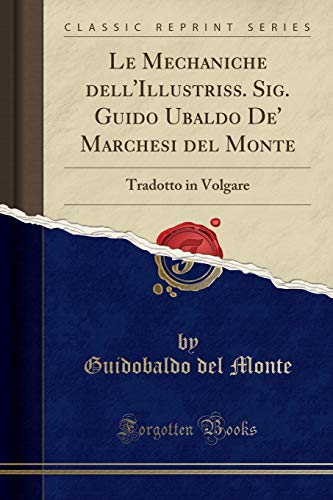
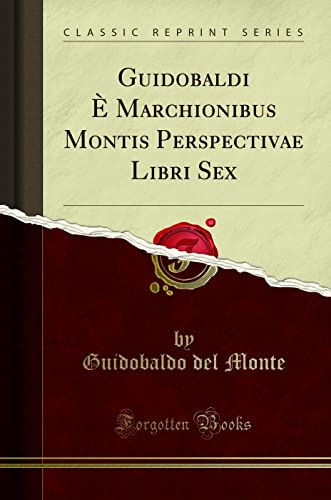
![Imagen del vendedor de Guidiubaldi e Marchionibus Montis Planisphaeriorum vniuersalium theorica (1579) [Leatherbound] a la venta por S N Books World](https://pictures.abebooks.com/inventory/md/md30638273186.jpg)
![Imagen del vendedor de Le mechaniche dell'illvstriss. sig. Guido Vbaldo de'marchesi del Monte. Tradotte in volgare dal sig. Filippo Pigafetta. Nellequali si contiene la vera dottrina di tutti gli istrumenti principali da mouer pesi grandissimi con picciola forza. . (1581) [Leatherbound] a la venta por S N Books World](https://pictures.abebooks.com/inventory/md/md30877525393.jpg)
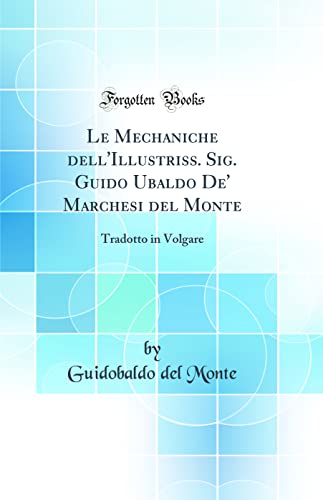
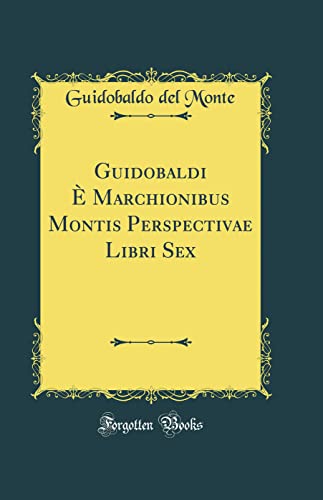

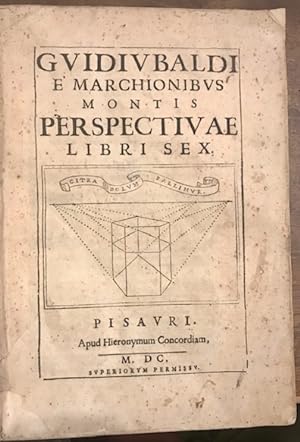
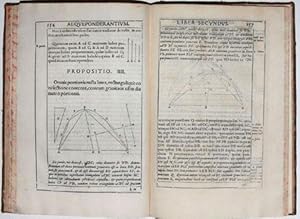
![Imagen del vendedor de In duos Archimedis Aequeponderantium libros paraphrasis scholijs illustrata. Pesaro: apud Hieronymum Concordiam, 1588 [colophon, 1587]. [Bound with:] SCALETTI, Carlo Cesare. Scuola mecanico-speculativo-pratica in cui si esamina la proporzione, che hà la potenza alla resistenza del corpo grave, e la causa per la quale la suddetta potenza si estenda a maggior'attività mediante la machina; opera utile all'uso civile, e militare necessaria ad ogni matematico, ingegniero, architetto, machinista, e bombardiere. Bologna: Costantino Pisarri, 1711 a la venta por SOPHIA RARE BOOKS](https://pictures.abebooks.com/inventory/md/md30259866149.jpg)

